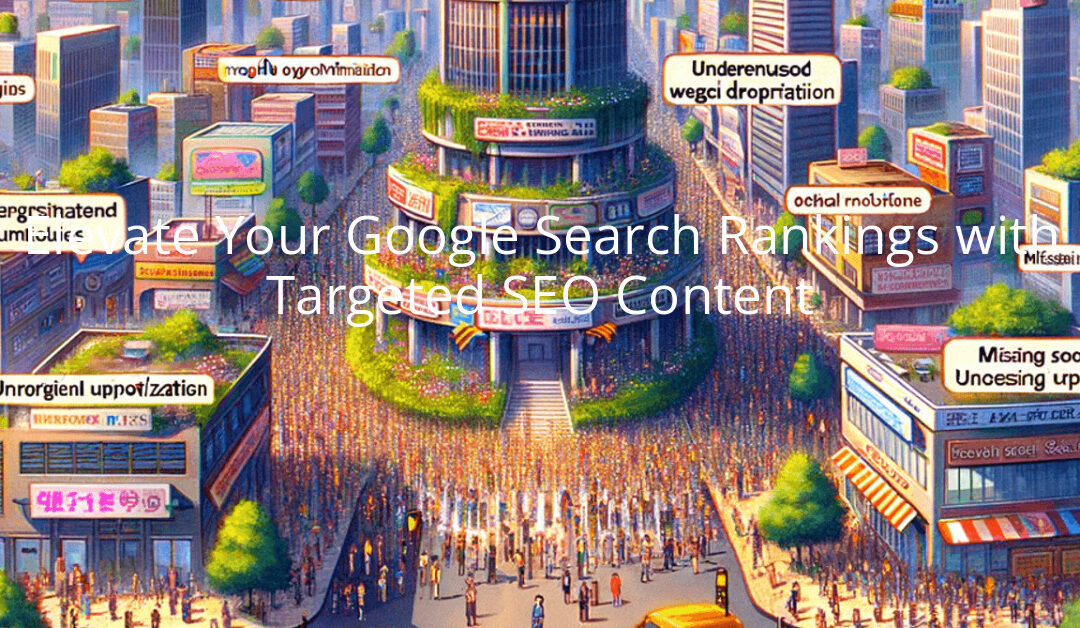Picture this: You’ve crafted a beautiful website, stocked it with insightful articles and helpful tips, and now you’re waiting for the steady stream of visitors to arrive. But instead of a bustling hub of activity, your analytics page remains a ghost town. You refresh it. Still, a trickle. What happened to the traffic you expected?
In a crowded online world, a quality website alone isn’t enough. If search engines aren’t seeing you, chances are, your audience won’t either. Google may be a data-driven giant, but it values relevance and accuracy just as much as technical prowess. Here, we’ll break down the five critical mistakes holding back your content from high search rankings and provide targeted strategies to fix them. Together, let’s set your content up for a clear path to the top.
Related: Going Beyond: Strategies to Amplify Your Content and Engage a Wider Audience
1. Neglecting Audience-Focused Keywords: Missing the Mark on Search Intent
Imagine you’re trying to find the latest bestseller at the library, but all the books are in the wrong sections. That’s the effect of using mismatched keywords in your content. Many creators fall into the trap of choosing high-traffic terms without considering their audience’s intent—leading to content that may attract a click but doesn’t satisfy the searcher’s need.
How to Get It Right: Choose keywords that resonate with your audience’s specific needs. For example, if your audience is searching for “budget-friendly family vacation spots,” don’t settle for generic “vacation tips.” Specific keywords tell Google exactly who your content is for. Tools like ContentERP’s keyword research module can guide you toward high-intent keywords that match your audience’s exact needs, helping you strike that ideal balance between relevance and search volume.
2. Crafting Forgettable Meta Descriptions: A Lost Opportunity for Attraction
Think of the meta description as a movie trailer for your content—a brief yet enticing snippet designed to pull readers in. Many websites either skip this crucial step or leave it to an automated generator. The result? A bland, uninspiring preview that doesn’t quite do justice to the content itself.
How to Get It Right: Write meta descriptions that combine intrigue with relevant keywords. Aim for clear and compelling summaries that hint at the value of your article without giving everything away. For instance, “Discover the top 10 ways to save on family vacations without skimping on fun” works better than a vague “Travel tips for families.” ContentERP’s description optimizer can help ensure your meta tags are unique, engaging, and perfectly tailored for the algorithm.
3. Ignoring Mobile Optimization: Failing to Meet Readers Where They Are
Today, over half of all searches come from mobile devices. Yet, despite this fact, many creators overlook mobile optimization, assuming their desktop-ready site will do the trick. Imagine opening a beautifully designed magazine that’s unreadable—font too small, images misplaced—when viewed on your smartphone.
How to Get It Right: Design with mobile in mind from the start. Ensure text, images, and menus are responsive and user-friendly on smaller screens. Google rewards mobile-friendly sites with higher rankings, so making your site accessible on all devices is an SEO essential. ContentERP’s mobile optimization tools allow you to see your site from a mobile user’s perspective, helping you smooth out any glitches and give users a seamless experience.
4. Overlooking the Importance of Alt Text: The Silent Booster for Visibility
In the world of SEO, images aren’t just visual elements—they’re opportunities to add context and keywords. But all too often, images are posted without descriptive alt text, leaving a critical SEO boost untapped. It’s like telling half the story and assuming everyone knows the rest.
How to Get It Right: Write concise, descriptive alt text that includes relevant keywords. Imagine you’re describing the image to someone who can’t see it: what essential details would help paint a clear picture? For example, rather than “picture of mountain,” try “sunrise over the Rocky Mountains with autumn foliage.” ContentERP’s alt text tool offers real-time prompts to help make the most of this simple yet powerful SEO strategy.
5. Posting Infrequent or Inconsistent Content: Losing Your Place in the Algorithm
SEO isn’t a set-it-and-forget-it game. Regularly published, high-quality content signals to search engines that your site is active, reliable, and worth revisiting. Yet many creators fail to keep up, posting sporadically or letting long stretches go by without fresh content. Imagine trying to keep a fire alive by adding wood once a month—it’s simply not enough to maintain momentum.
How to Get It Right: Build a content calendar that allows you to post consistently, whether weekly, bi-weekly, or monthly. Consistency keeps both readers and algorithms engaged. With ContentERP’s content scheduler, you can map out topics, plan publishing dates, and ensure a steady flow of new material—allowing you to keep your site fresh and Google’s attention firmly on your content.
Setting Your Content Up for Long-Lasting Success
Imagine your website as a lively city center, with visitors flowing in from all corners, engaging with your work, and returning for more. With the right SEO strategies, your site can achieve this kind of vibrant visibility. Avoiding these five missteps—targeting the wrong keywords, underusing meta descriptions, neglecting mobile optimization, skipping alt text, and posting inconsistently—will set your content up for greater exposure, driving more traffic, and ultimately helping your business thrive.
SEO doesn’t have to be overwhelming or mystifying. With ContentERP, it’s simpler than ever to keep your site in top shape. ContentERP’s suite of SEO tools, from keyword insights to mobile optimization checks, takes the guesswork out of search strategy, giving you more time to focus on creating content that resonates.
Ready to transform your content’s reach? Sign up for ContentERP today and let your website achieve the search ranking heights it deserves.
Related: Avoid These 5 Content Mistakes to Stay on Google’s Good Side

